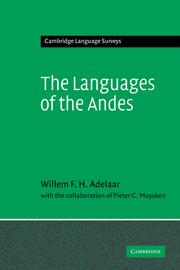Book contents
- Frontmatter
- Contents
- List of tables
- List of maps
- Preface
- Orthographic conventions
- List of abbreviations
- 1 Introduction
- 2 The Chibcha Sphere
- 3 The Inca Sphere
- 4 The languages of the eastern slopes
- 5 The Araucanian Sphere
- 6 The languages of Tierra del Fuego
- 7 The Spanish presence
- Appendix: Inventory of languages and language families of the Andean region
- References
- Author index
- Index of languages and ethnic groups
- Subject index
6 - The languages of Tierra del Fuego
Published online by Cambridge University Press: 22 September 2009
- Frontmatter
- Contents
- List of tables
- List of maps
- Preface
- Orthographic conventions
- List of abbreviations
- 1 Introduction
- 2 The Chibcha Sphere
- 3 The Inca Sphere
- 4 The languages of the eastern slopes
- 5 The Araucanian Sphere
- 6 The languages of Tierra del Fuego
- 7 The Spanish presence
- Appendix: Inventory of languages and language families of the Andean region
- References
- Author index
- Index of languages and ethnic groups
- Subject index
Summary
On Tierra del Fuego, the archipelagos surrounding it and the neighbouring mainland, Patagonia, nine indigenous languages were spoken, of which only a few have survived to the present day. With respect to the peoples of Tierra del Fuego, a distinction is made traditionally between the canoe nomads, including the Chono, the Kawesqar and the Yahgan, and the foot nomads, including the Haush and the Selkʹnam. In the latter group the Gününa Küne, the Tehuelche and the Tehues or Teushen are also included (Clairis 1985).
As Guyot (1968) notes, the area of Tierra del Fuego had already been visited by eighty-one exploratory expeditions by the time the HMS Beagle, carrying Charles Darwin, passed through the area. Different visitors projected different images onto the nomadic groups they encountered. Thus Darwin writes: ‘The language of these people, according to our notions, scarcely deserves to be called articulate’ ([1906] 1983: 195). The Fuegians could be seen as a decidedly lower step in human development, in his perception.
It was against this view that Thomas Bridges, a missionary in the area from 1869 to 1887 on behalf of the South American Missionary Society, argued with his massive 30,000-word Yahgan–English dictionary.
- Type
- Chapter
- Information
- The Languages of the Andes , pp. 550 - 584Publisher: Cambridge University PressPrint publication year: 2004

